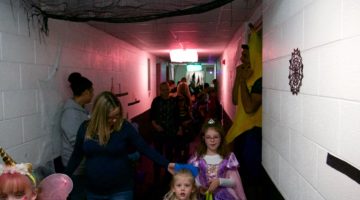You enter the first dark corridor and immediately you notice the walls are covered in spider webs and chains. You look down and fake fog crawls across the floor and the smell of fake blood fills your nasal cavity. Flashing strobe lights disorientate you and a man dressed as a zombie waits around the corner to launch in your direction and make you jump out of your skin. Creepy music and screaming drone in the background as you make your way past gory animatronics and horrific scenes. You are in one-of-a-thousand haunted houses scattered across America, and as you run out of it screaming your head off, one has to wonder why being scared out of your wits is so much fun.
According to hauntrepreneurs.com, haunted houses draw an estimated 35 million fright enthusiasts annually and have emerged into an over $300 million industry. Their popularity is only increasing in the United States with the number of haunted attractions ranging around 2,500 in 2013 to a little over 4,000 this year. And it isn’t unusual for a large haunted attraction to bring in $2-3 million in a season. So it’s clear that America loves to be scared, but why?
The beginning of this answer lies in two different parts of our brain; the amygdala and the prefrontal cortex. The amygdala is responsible for the “flight or fight” response. When presented with a threat, the heart rate begins to increase, adrenaline pumps through the body, lungs expand and the body has more energy just in case there’s a need for flight or fight. The rush of chemicals and hormones that flood our brains in this physical state are present whether the threat is real or not. This makes us more attentive and curious and it’s harder for us to look away. The prefrontal cortex is the brain’s evaluator, it assesses whether or not the threat is real. Once again, even if we know we are safe, the physical state of flight or fight is still there.
Another explanation for our enjoyment of things morbid and gruesome is called “The Boomerang Effect.” It’s basically the idea that things that we try to oppress within ourselves or that society tries to oppress (in this case fear or morbid curiosity) are more appealing because they are socially unacceptable. We use Halloween as an excuse to explore the dark side of our minds, our own morbid curiosity because any other time of year to express such enthusiasm for horror would be considered weird. Haunted houses also provide us with a way to release our real life fears. Throughout our daily lives, we worry about things like bills, societal status, relationships and loans — things that scare us for very different reasons. People can release the fears of real life by being afraid of a teenager in a werewolf mask growling at them through a blood stained bed sheet. It’s therapeutic, in a weird way.
Facing the disturbing, gruesome and downright terrifying is also a way for us to prove our strength. Haunted houses present a challenge for us. Bragging rights and “I survived” T-shirts are distributed among those who can survive the country’s top haunted houses like the Freakling Brother’s “Trilogy of Terror” or McKamey Manor in San Diego. Making it through these terrors is our way of saying “I did it! I conquered something disturbing! I’m stronger than you!”
Haunted houses are about imagination. We know they are fake, that’s why we are willing to enter them. We put ourselves in an environment where we can pretend to be chased by crazy clowns with chainsaws, or thrown in the middle of a hillbilly cannibalistic hell. Ultimately, we are pretending to be in an environment where our imaginary existence is in jeopardy. It is often thought this has to do with our acceptance of our own mortality. It’s a part of us that understands how fragile our lives and the lives of those around us are, therefore, our desire to challenge that fragility (without actually jeopardizing it) is part of the deeper root of the attraction to haunted houses. Accepting that you could die at any minute in the pretend realm of haunted attractions is a safe way to face your own mortality without having to dive into existential questions like “why is this happening?”
Finally, haunted houses are most often visited in groups. It is a group Halloween attraction after all. Most people would be too afraid to venture into even a mediocre haunted house by themselves, so the idea of “safety in numbers” applies here. But it still goes a little deeper than that. Once again, social acceptance plays a role here. If you jump and scream at a fake spider that drops from the ceiling and your friend screams at it too, your fear of that spider is validated. Most likely you will find comfort in the fact that your fears are equal to that of others. If you jump at the spider and your friend laughs, you might feel a little embarrassed or “wimpy.” This goes back to what we discussed earlier, using scary things to prove your own strength. So haunted houses are a way for some groups to share in fear while other groups use it as a way to rank themselves. My friend, Sarah, summed this up for me in a quote once, saying, “I’m too Disney for your Rob Zombie.”
So for all of you who are a little more daring and in-tune with your morbid side, I hope you’ve learned a little more about yourself and the dare-devil, mortality challenging, freaks that you are. Fright Fest is now open in Reno if you are looking for a good local scare. It is located at the Reno Aces Stadium and runs until Oct. 31. If you are willing to travel, there is also “Frightdome” and “Trilogy of Terror,” located in Las Vegas. Details are online. Have fun out there and happy Halloween.
Lauren Gray studies journalis. She can be reached at alexandraschultz@unr.edu and on Twitter @NevadaSagebursh.













